Wireless
Are Wi-Fi Repeaters and Extenders Beneficial?
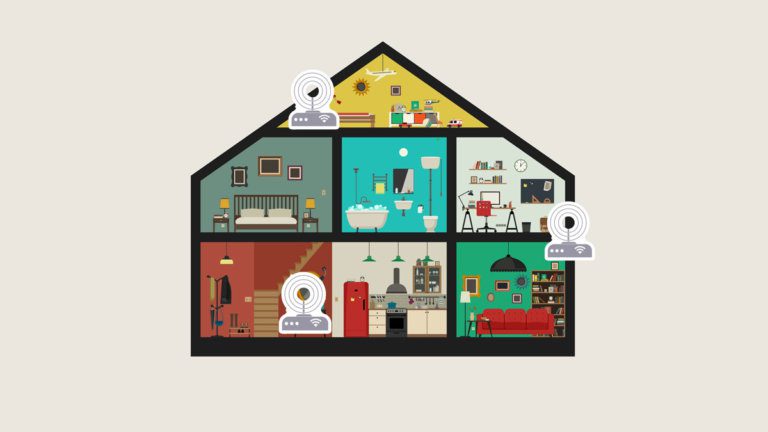
Subscribers today often supplement their existing Wi-Fi Access Points (AP) with wireless repeaters and extenders to enhance Wi-Fi coverage within the home network. Frequently, we are asked if these devices provide any real benefit.
To answer these questions, we ran some tests in a house to measure and compare the relative performance of a couple of off-the-shelf wireless repeaters and extenders.
Results from the field tests
Since the industry is all over the place with the definition of Repeaters and Extenders, we came up with our definition. We define a Wi-Fi repeater as a device that uses a single radio and channel to relay traffic between a client and an AP. Since the repeater uses the same channel to relay data between the client and the AP, the data must be on the channel/radio twice. A Wi-Fi extender, on the other hand, is a device with two or more radios that dedicate one radio and channel to bridge client traffic to/from an AP, while using another radio and channel to communicate with clients. For our comparison we used the following configurations.

Figure 1: Repeater and Extender Configuration
A single AP without any repeaters or extenders provided coverage with -67dbm or better RSSI within the test house. As we expected and also demonstrated in Figure 2, the wireless repeaters and extenders did help in extending the wireless coverage. We observed this coverage increase in at least four locations outside the home. Inside the house, we observed a new minimum RSSI of -50 dBm with extenders and -58 dBm with repeaters (17 dB and 11 dB respectively better than with the AP alone). Additionally, our findings also demonstrate improvements in client throughput performance not only in the extended coverage areas but also in some of the areas otherwise covered with the AP.
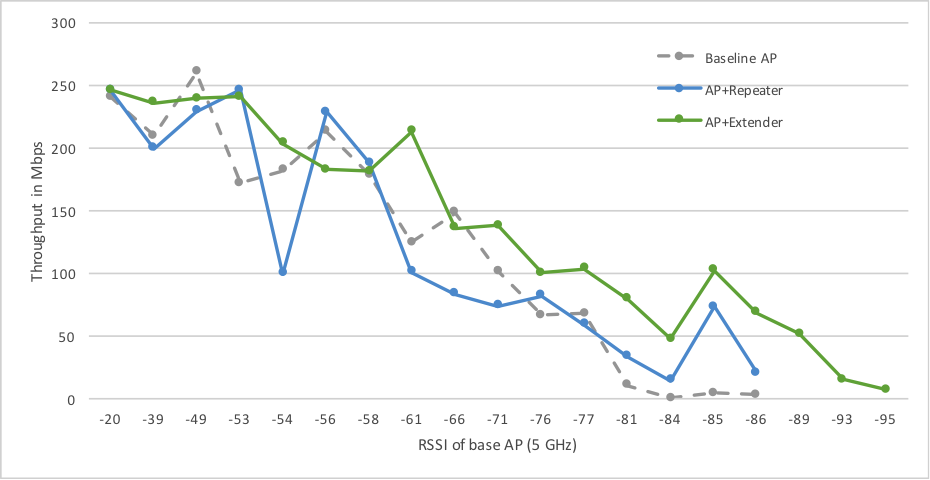
Figure 2 - Throughput vs. Path Loss:
Baseline AP vs. (AP + Repeater) vs. (AP Extender)
In our testing, the extender provided better coverage improvements and throughput than the repeater. The better coverage improvements with the extender are due to the fact that the extender is using a 2.4 GHz band for the fronthaul, while Wi-Fi repeater is using the 5 GHz band. The 2.4Ghz supports better propagation characteristics compared to the 5Ghz band. The extender configuration offered better throughput performance in the extended areas than the repeater. Primarily, this is because the repeater time-shares the same channel to communicate to the client (front-haul) and AP (backhaul). The extender, on the other hand, uses a separate radio and channel to communicate to the client (front-haul) and AP (backhaul).
Are there any unexpected surprises to be aware of with multiple Wi-Fi nodes in a home?
A significant observation from the test results is that the client did not always connect to the Wi-Fi node with the “best” throughput performance. In some locations (represented with green dots in Figure 3), the client chose to connect to the repeater, even though it would have got a better throughput had it connected to the AP. The client appeared to be making Wi-Fi node selection decisions solely based on the received signal strength, which may result in sub-optimal or even very poor network performance. Since a client has limited avenues for knowing which node will offer better throughput, this warrants the need for coordination between the APs, and also between the AP and client in the home.
CableLabs is actively working with the Wi-Fi Alliance (WFA) to develop new certifications (e.g., MBO) programs to enable coordination between AP and clients. We are also engaging with the CPE vendors about the need for AP coordination.
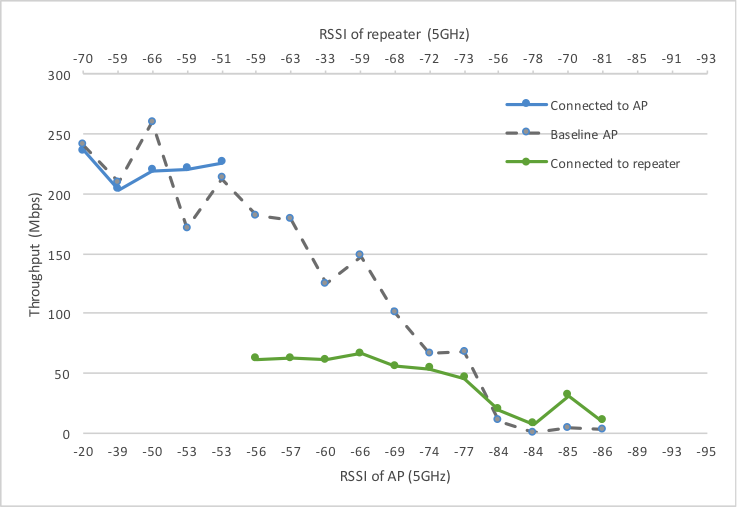
Figure 3: Throughput vs. Path Loss: AP versus AP + Repeater
As shown in this blog, the Wi-Fi repeater and extenders are helpful in extending Wi-Fi coverage. However, some coordination between AP and repeater/extender devices is needed to make sure clients are always connected to the “right” node.
Vikas Sarawat is a Director in the Wireless (R&D) Group at CableLabs.
Networking
In-home Wi-Fi Networks: Today, Tomorrow, and Beyond

Do you have broadband Internet service? If yes, most likely you also have a Wi-Fi Access Point (AP) for wireless connectivity in the home. Today, in-home Wi-Fi is almost ubiquitous in the countries with developed economies, and the penetration is only growing. A new iGR study forecasts that almost 98 percent of broadband data use in U.S. households will be on Wi-Fi devices by 2018.
Emergence of Operator Managed In-home Wi-Fi
The demands on home networks have increased over time. In the past customers would connect a few computers directly to a cable modem using Ethernet or USB. Then customers wanted the convenience of receiving wireless data at their laptop so they could read E-mail or surf the web. Customers achieved this by going to a retail outlet and purchasing a Wi-Fi access point, which they would plug into the cable modem. Now broadband service providers are taking on the responsibility of providing and installing the access point. This raises the customer’s expectation. An additional complication is that customers want to stream videos to their smart phones, laptops, and tablet computers.
Recent Wi-Fi Technology Improvements
Over the last decade Wi-Fi performance has also improved significantly. The latest Wi-Fi standard – 802.11ac – promises support for more than 1 Gbps of speed. Many Wi-Fi products support Multiple Input Multiple Output (MIMO) and Transmit Beamforming. These technologies promise greater reliability and better performance.
For instance, as shown in the chart below, 802.11ac delivers higher throughput than 802.11n as a result of the support for 256 QAM. 802.11n supports up to 64QAM only.
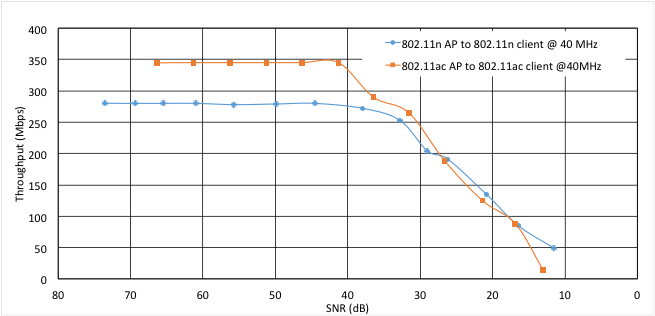
Factors Impacting In-home Wi-Fi Performance
While Wi-Fi, in most cases, works as expected, in-home Wi-Fi network performance is highly dependent on a number of variables, including materials used for house construction, distance between AP and Client, level and type of interference, Multiple Input Multiple Output (MIMO) configuration, Transmit Beamforming (TxBF), antenna orientation, RF spectrum, background traffic, and device capabilities.
Additionally, Wi-Fi utilizes unlicensed spectrum that is not solely under the control of operators. Numerous devices (e.g. microwave, cordless phones) with a variety of technologies may utilize the spectrum. As a result, Wi-Fi may be subject to radio disturbances that may be immitigable.
Considerations for In-home Wi-Fi Deployment
Interference can be a significant issue and AP location and channelization should be set to avoid it. Not only co-channel, but adjacent channel and alternate channel interference can also be significant issues. Intelligent tools such as Automatic Channel Selection, Radio Resource Management (RRM), and Self Organizing Networks (SON) should be considered to help with interference mitigation.
The 5 GHz band offers more channels and is less crowded than the 2.4 GHz band and should be considered for in-home Wi-Fi deployments. Dual Band Dual Concurrent (DBDC) APs, which allow use of both bands simultaneously, are also available and should also be considered for in-home Wi-Fi deployments.
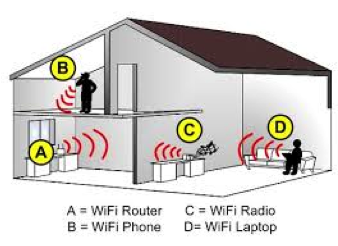
Support for Wireless Multimedia (WMM) and airtime fairness is recommended for in-home Wi-Fi networks in order to prioritize real-time application over background traffic and prevent slower clients (e.g. legacy) from dominating the airtime. Currently, Airtime Fairness is not part of Wi-Fi standards.
Although the 2.4 GHz band offers better distance coverage, Wi-Fi signals in the 5 GHz band provide excellent coverage as well in homes with drywall panel walls. Analysis shows that three HD video streams can be successfully transmitted to three Wi-Fi clients up to 80 feet from the AP in a home with drywall construction. Wi-Fi signals in the 5 GHz band offer more limited coverage in houses with brick walls (or concrete floors). In these houses, HD video streaming is possible if there is only one wall between the AP and clients. Wi-Fi signal attenuation is too high for two or more brick walls to reliably support HD video streaming. In cases where a single Wi-Fi AP is not sufficient to provide whole house coverage and required performance, there are multiple options for the consumer and operators to improve Wi-Fi coverage and performance. A few examples of these include:
- Multimedia over Coax (MoCA) to Wi-Fi extenders
- Power Line Communications (PLC) to Wi-Fi extenders
- Wi-Fi mesh (e.g. 802.11s)
- Wi-Fi repeater
- Or a combination of the options above
Transmit Beamforming (TxBF) and spatial division multiplexing improve wireless system performance. Increasing the number of spatial streams increases the Wi-Fi system throughput; however, the relative gain in throughput is diminished as the number of spatial streams increases. TxBF is not standardized in 802.11n, resulting in a lack of interoperability. On the other hand TxBF is standardized in 802.11ac.
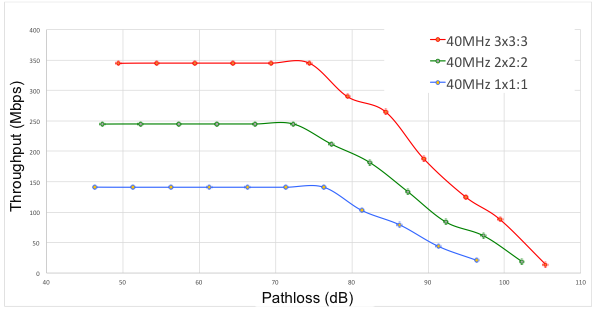
Additionally, Optimum placement of the AP in the customer house can make a significant difference in Wi-Fi signal coverage and performance. Recommendations and guidelines for in-home Wi-Fi installation will be covered in detail in a future blog post.
Summary
Demands on in-home Wi-Fi networks are only growing. There are many factors influencing the performance of in-home Wi-Fi networks. Proper deployment and management of In-home Wi-Fi networks can help improve customer experience.
Future Work
As of this writing, home networks and in-home Wi-Fi topics are active areas of research within CableLabs. If you are a supplier and want to get involved, please see the information here on how to engage. We plan to write additional blogs on this topic in the near future.
Also, CableLabs released a vendor RFI (on July 20, 2014) to the vendor community with an objective of soliciting information about current and future generation vendor products, architectures and technologies related to home networks and also to gauge vendor participation in the Future Home Networks project.
Vikas Sarawat is a member of the wireless group at CableLabs. He leads several initiatives related to home networks and wireless networks.



